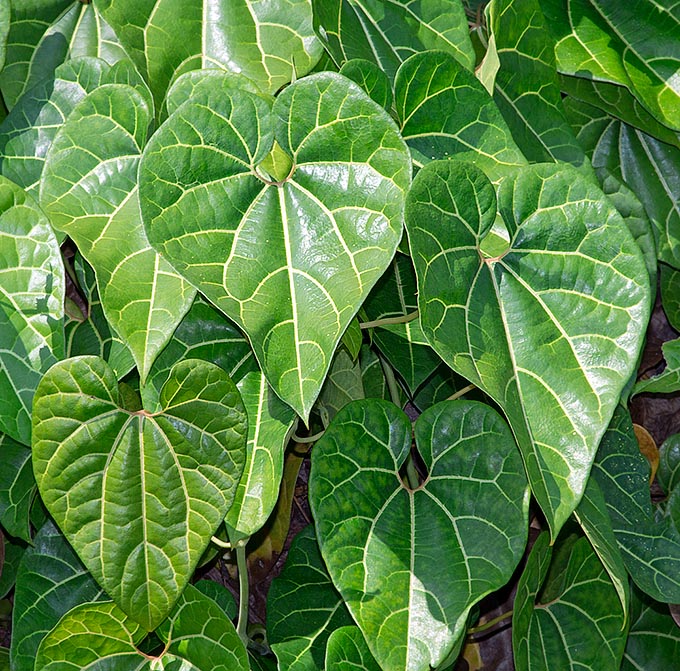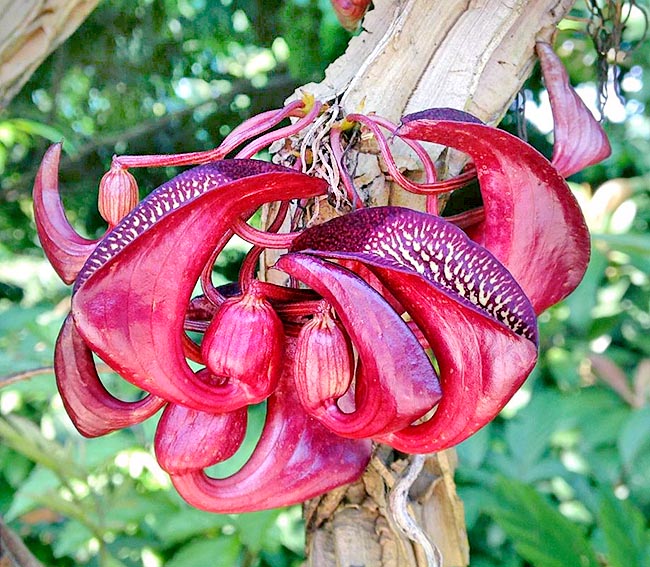Family : Aristolochiaceae

Text © Pietro Puccio

English translation by Mario Beltramini

Native to Colombia, Costa Rica, Panama and Peru, Aristolochia leuconeura is a perennial climber with stems lignifying at the base, suberose, deeply fissured, up to 5 cm of diametre and 6 m long. Very decorative leaves with medicinal virtues © Giuseppe Mazza
The species is native to Colombia, Costa Rica, Panama and Peru where lives in the humid forests often at the edges of the clearings and of the waterstreams, from the sea level up to about 1000 m of altitude.
The generic name comes from the combination of the Greek terms “ἄριστος” (aristos) = the best, excellent, and “λοχεια” (locheia) = delivery, with reference to the belief that the plant did favour the delivery; the specific name is the combination of the Greek adjective “λευκός” (leucόs) = white and of the substantive “νευρᾶ” (neura) = nerve, with reference to the whitish nervations of the leaves.
Common names: yawar panka, machakuy, waska, wankawi sacha (Peruvian Amazonia).
The Aristolochia leuconeura Linden (1858) is an evergreen, perennial climbing species, with stems lignifying at the base, up to 5 cm of diameter, suberose, deeply fissured, up to 6 m long.
The leaves, on a 7-10 cm long petiole, are alternate, simple, cordiform with pointed apex and bilobed base, coriaceous, of glossy dark green colour with marked yellow-whitish nervations, 8-12 cm broad and 10-18 cm long.
The flowers, produced in group in the lower part of the old stems (cauliflory) without leaves, are formed only by the funnel-shaped calyx, about 6 cm long, swollen at the base, with curved tube ending with an obliquous expanded lobe, ovate, of purple colour outside, with cream yellow dottings and striations inside and fauces wholly covered by hair of the same colour that favour the entrance of the pollinating insect, but that hinder its exit until when the fecundation has occurred; the flowers emit a disgusting odour.

Flowers grow at the leafless stems base. They stop the pollinators freeing them only after fecundation © G. Mazza
The fruits are cylindrical dehiscent capsules with 6 ribs, up to 18 cm long and 1,5 cm of diameter, containing numerous flat seeds.
It reproduces by seed in draining loam rich of humus maintained humid at the temperature of 22-24 °C.
Species rare in cultivation, vigorous and fast growing that needs robust supports, appreciated especially for the big ornamental leaves, being the flowers often hidden by the foliage, suitable for the tropical and subtropical climate zones in full sun or partial shade, its cultivation may be tried in the milder temperate ones where values of temperature around the 0 °C are exceptional and short lasting occurrences.
It prefers soils rich of organic substance, acidic to neutral, maintained almost constantly humid.
Cultivable also in pot for the decoration of greenhouses, verandas and luminous winter gardens, with lowest winter values preferably not under the 14 °C.
The waterings must be regular from spring to autumn, more spaced in winter, but without ever letting the loam to dry up completely, with fertilizations, during the vegetative period, done preferably with balanced products with microelements at half the dosage suggested by the producer.
The leaves are utilized by the local populations of Amazonia as emetic, laxative and against the bronchitis.
Synonyms: Aristolochia veraguensis (Klotzsch) Duch. (1864).
→ To appreciate the biodiversity within the family ARISTOLOCHIACEAE please click here.
